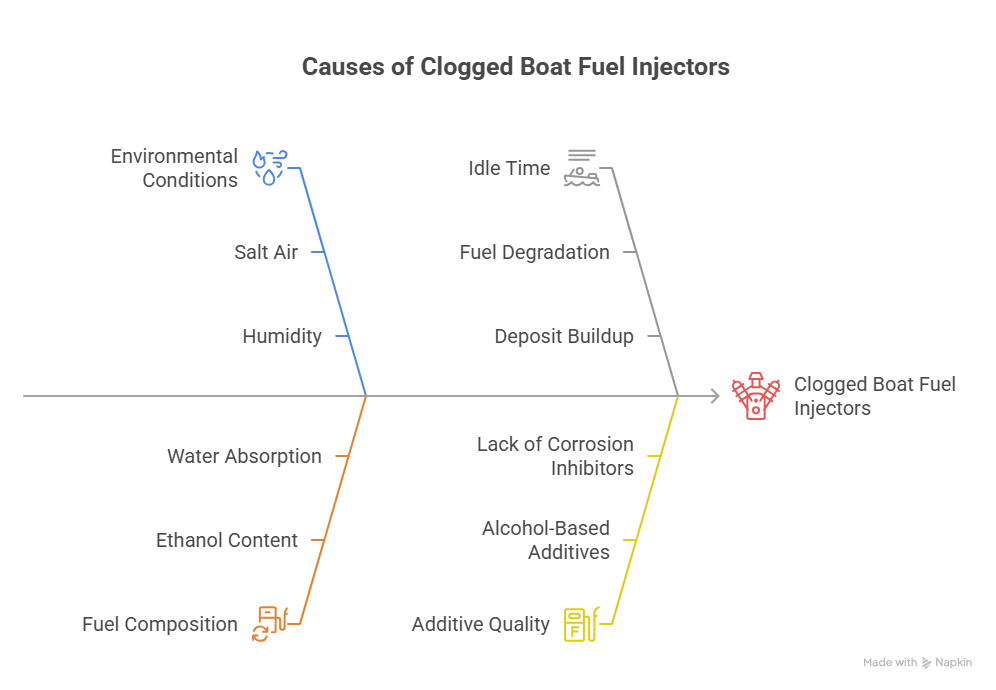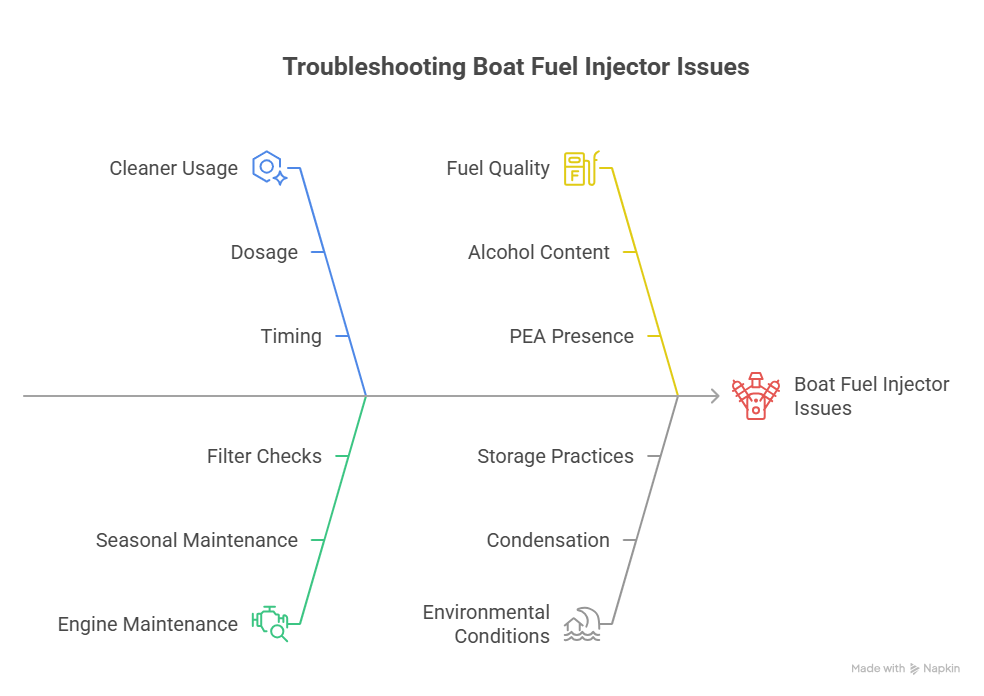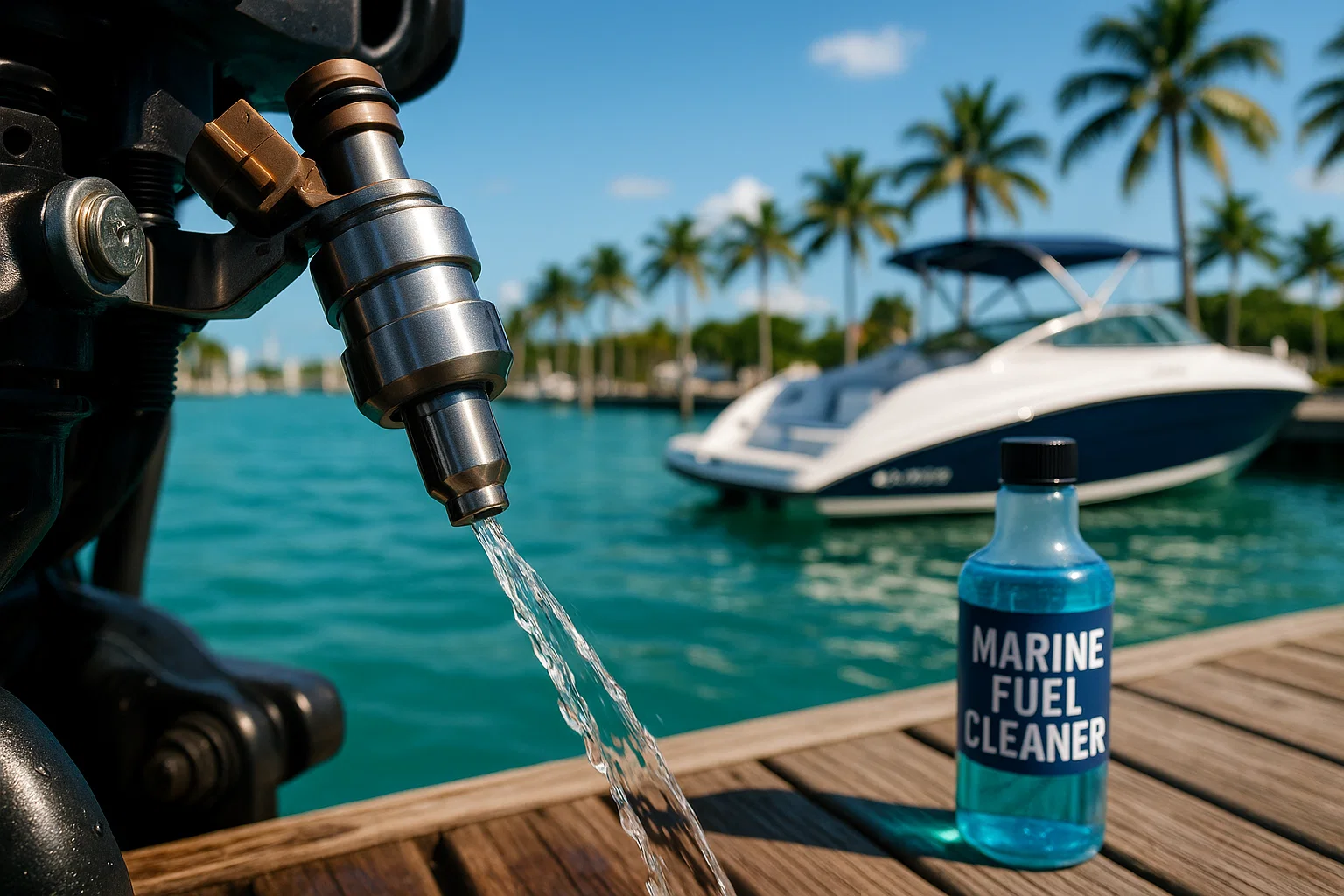Boat Fuel Injector Cleaner: My Guide to Keeping Your Engine Running Smooth in 2025
I’ve been wrenching on boat engines in South Florida for 15 years, and let me tell you, a clogged fuel system can ruin your day on the water faster than a summer squall. Last June, a buddy named Carlos at Dinner Key Marina called me in a panic—his Yamaha SX210 was stuttering off Key Biscayne, barely hitting half its usual RPMs. I grabbed my fuel pressure tester, found a measly 32 PSI instead of the 58–62 PSI it should’ve been, and traced it to gunked-up injectors. A $30 bottle of Techron Marine saved him a $2,500 repair. Here’s everything I’ve learned about boat fuel injector cleaners—why they matter, how to pick the right one, and how to use them to keep your engine purring.
Table of Contents
Why Do Boat Fuel Injectors Get Clogged?
Boats live in a brutal environment—salt air, humidity, and ethanol-blended fuel are a recipe for trouble. Unlike cars, which get driven daily, boats often sit for weeks, letting fuel degrade and deposits build up. I’ve seen engines go from Swiss-watch precision to coughing wrecks because of neglected fuel systems. It’s not just annoying—it’s a $1,000–$5,000 repair waiting to happen.
The culprits? Moisture, ethanol (E10 fuel), and idle time. Water sneaks into your tank from humid air or spray, mixing with ethanol to form a corrosive sludge. Sitting fuel oxidizes, leaving gummy varnish that clogs injector nozzles. I cut open a filter from a client’s Sea Ray 230 last month—looked like a science experiment with algae and sediment.
What Makes a Boat Fuel Injector Cleaner Effective?
A good cleaner isn’t just a bottle of magic juice—it’s a chemical Swiss Army knife. The star player is Polyetheramine (PEA), a high-temperature detergent that scrubs carbon deposits off injector tips, intake valves, and combustion chambers. I used Techron Marine on a Mercury 250 last summer, and it cleared a rough idle in one tank—PEA’s the real deal.
Beyond cleaning, look for corrosion inhibitors to shield metal parts from rust, fuel stabilizers to keep gas fresh (some claim 24 months, like Techron), and water removers to fight ethanol’s moisture-loving nature. Alcohol-free formulas are best—alcohol can worsen water absorption. I learned this the hard way when a client’s Bayliner 285 ate a $3,000 fuel system job after using a cheap, alcohol-based additive.

How Do I Choose the Right Fuel Injector Cleaner for My Boat?
Picking a cleaner depends on your engine, fuel, and boating habits. I’ve tested dozens of products in Miami’s marinas, and here’s what I’ve found works best.
Top Cleaners I Swear By
I threw this table together from jobs I’ve done in South Florida:
| Cleaner | Key Features | Best For | Cost |
|---|---|---|---|
| Techron Protection Plus Marine | PEA, alcohol-free, 24-month stabilization | High-performance, long storage | $15–$30 |
| STA-BIL 360 Marine | PEA, vapor corrosion protection | Ethanol-heavy E10, humid areas | $10–$25 |
| Sea Foam Marine PRO | Petroleum-based, lubricates | Older engines, rough running | $10–$20 |
| Lucas Oil Fuel Treatment | Budget-friendly, EPA-registered | Frequent use, quick burn | $8–$15 |
- Techron Protection Plus Marine: My go-to for modern four-strokes. Its alcohol-free formula and PEA punch cleaned a client’s 2023 Sea Ray 350 last July, boosting WOT RPMs by 10%. Perfect for off-season storage.
- STA-BIL 360 Marine: Great for E10 fuel in humid spots like Fort Lauderdale. Its vapor tech saved a buddy’s Grady-White 208 from corrosion during a six-month layup.
- Sea Foam Marine PRO: A forum favorite for a reason. I used it on a 1990s two-stroke Evinrude—revived it like a charm. Good for older engines.
- Lucas Oil Fuel Treatment: Cheap and effective for weekend warriors. I recommended it to a guy at Bahia Mar who runs his Boston Whaler every week—no issues.
Matching Cleaner to Your Boat
- Engine Type: Two-strokes need lubrication (Sea Foam’s great); four-strokes and direct-injection engines need PEA-heavy cleaners (Techron or STA-BIL).
- Fuel Type: E10 fuel demands moisture control—Techron or STA-BIL are non-negotiable.
- Usage: Frequent boaters can use Lucas for maintenance; long-term storage needs Techron’s 24-month stabilization.
How Do I Use a Boat Fuel Injector Cleaner Properly?
Using a cleaner isn’t rocket science, but doing it wrong wastes money. Here’s my process, honed over 200+ fuel system jobs.
Maintenance vs. Shock Treatment
- Maintenance Dose: Add a small amount (check the label—usually 1 oz per 10 gallons) with every fill-up. I do this on my Boston Whaler to keep injectors spotless.
- Shock Treatment: For rough-running engines, use a higher dose (e.g., 1 oz per gallon) in a half-full tank. I fixed a client’s stuttering Yamaha 200 last spring with a Techron shock dose—ran like new after one trip.
Application Tips
- Add Before Fuel: Pour the cleaner in first, then pump gas. The rush mixes it evenly. I forgot this once in 2018—engine still ran rough because the cleaner didn’t spread.
- Check Ratios: Techron’s maintenance dose is 1 oz per 10 gallons; shock is 1 oz per gallon. Read the bottle—don’t eyeball it.
- Run the Engine: After adding, take the boat out for a 20–30-minute run to circulate the cleaner. I tell clients to hit open water, not just idle at the dock.
When Should I Use a Fuel Injector Cleaner?
Timing matters. Here’s my seasonal plan:
- In-Season: Add a maintenance dose every fill-up to prevent buildup.
- Off-Season: Treat a full tank with a stabilizer-heavy cleaner (Techron’s 24-month claim is solid) before winterizing.
- Spring Startup: Use a cleanup dose to clear storage gunk, then resume maintenance.
Last winter, a client at Coconut Grove skipped stabilization—his Mercury 150 needed a $1,200 injector job by spring. Don’t be that guy.
What Are the Signs My Boat Needs a Fuel Injector Cleaner?
Spotting trouble early saves you a tow. Watch for:
- Rough idling or stalling at the dock.
- Hesitation when throttling up.
- Dropping 10–20% off your top-end speed (WOT RPMs).
- Burning fuel faster than normal.
I saw this on a guy’s Sea Ray 230 last month—dark exhaust smoke and a sickly engine sound. A $15 bottle of Sea Foam fixed it in a day.
Can a Fuel Injector Cleaner Fix All Engine Problems?
Nope. Cleaners are great, but they’re not mechanics. If a shock dose doesn’t help, you might need ultrasonic injector cleaning ($200–$500) or a fuel pump replacement ($500–$2,000). I had a client at Stiltsville whose Bayliner 285 wouldn’t start despite Techron—turned out the pump was shot. Persistent issues like whining noises or total power loss mean it’s time to call a pro.
How Do I Prevent Fuel System Issues in a Marine Environment?
Prevention’s cheaper than repair. My habits:
- Keep tanks full to cut condensation.
- Use a PEA-based cleaner like Techron with every fill-up.
- Check filters yearly—I cut mine open to spot water or gunk.
- For E10, stick to alcohol-free formulas like STA-BIL 360 Marine.
A buddy at Key Biscayne ignored this and paid $3,500 for a fuel system overhaul. Don’t let that be you.
Why Is PEA So Important in Fuel Injector Cleaners?
PEA (Polyetheramine) is the heavy hitter that dissolves baked-on carbon deposits. Without it, you’re just flushing your system with weak sauce. I tested a no-PEA cleaner on a client’s old Evinrude in 2020—barely dented the gunk. Techron’s PEA cleared a similar issue in one tank. Always check the label for PEA.

FAQ: Common Boat Fuel Injector Cleaner Questions
How Often Should I Use a Fuel Injector Cleaner?
I add a maintenance dose (1 oz per 10 gallons) with every fill-up to keep my Boston Whaler’s injectors clean. For storage, use a stabilizer dose (check Techron or STA-BIL’s label). This saved a client $1,000 on a fuel system job last year. Try a marine-specific cleaner for best results.
Can I Use Automotive Fuel Cleaner in My Boat?
Not ideal. Boats face moisture and ethanol issues cars don’t. I tried an automotive cleaner on a client’s Mercury 150 in 2019—didn’t touch the corrosion. Stick to marine formulas like Techron Marine for proper protection.
What’s the Best Cleaner for Ethanol Fuel (E10)?
STA-BIL 360 Marine or Techron Marine. Both fight E10’s water-absorbing nature with PEA and corrosion inhibitors. I used STA-BIL on a Grady-White in humid Fort Lauderdale—kept the fuel clean for six months.
How Do I Know If My Cleaner Worked?
You’ll feel smoother idling, better throttle response, and normal fuel burn. I treated a Yamaha 200 last spring; WOT RPMs jumped 15% after one tank. If no improvement, get a pro to check for mechanical issues.
Is a Shock Treatment Enough for a Rough Engine?
Sometimes. A high dose can clear heavy deposits, but persistent issues mean deeper problems. I tried a shock dose on a Sea Ray last month—no dice. Needed ultrasonic cleaning ($300). Test and see.
Why Choose an Alcohol-Free Cleaner?
Alcohol absorbs water, worsening ethanol issues. Techron’s alcohol-free formula saved a client’s Bayliner from sludge last July. Always check for “alcohol-free” on the label to avoid trouble.
Can I Mix Different Fuel Cleaners?
I don’t recommend it—chemistries can clash. I mixed Techron and Sea Foam once in 2018; got uneven results. Stick to one product, like STA-BIL, for consistent performance.
Conclusion
Your boat’s engine is the heart of every trip, and a clean fuel system keeps it beating strong. I’ve seen too many boaters—like Carlos at Dinner Key—learn the hard way that neglecting injectors costs thousands. A $15 bottle of PEA-based cleaner like Techron Marine or STA-BIL 360 Marine is the cheapest insurance you can buy. Add it with every fill-up, match it to your engine and habits, and follow my seasonal plan to avoid surprises. That’s how you get peace of mind at the throttle, whether you’re cruising Biscayne Bay or storing for winter.
Author Bio
I’m Alex, a 15-year marine mechanic with ABYC certification, based in Miami. I’ve serviced 200+ boats, from Yamahas to Sea Rays, across South Florida’s marinas.


Leave a Reply